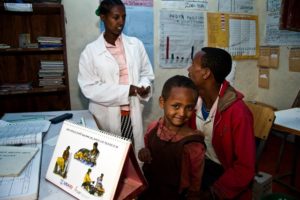
By Yasmin Chandani, SC4CCM Project Director

A young boy and his father visit a community health worker in Amhara Region, Ethiopia
Tomorrow is the Fifth World Pneumonia Day. The Global Coalition Against Child Pneumonia designated this year’s theme as Innovating to Fight Child Pneumonia. Innovation is the buzz word these days, so one could be forgiven for rolling one’s eyes and moving quickly onto the next newsworthy item, without considering why innovation is so important for pneumonia. Innovation is generally understood as the introduction of a new method, idea, product, etc. Why then is new thinking so critical for pneumonia as a global health problem – an old disease with an old cure – why is innovation so critical? It is true that pneumonia is one of the most solvable problems in global health, yet it still remains the #1 killer of children under five, claiming 1.1 million of these lives in 2012. The Global Coalition’s compelling infographic clearly lays out the simple strategies that exist for preventing pneumonia from killing so many children. But despite having these solutions at our fingertips, the global community is making slow progress in reducing the number of children that die every year.

A community health worker in Rwanda inspects his supply of CCM products.
This is why innovation is so important. We need new ways of implementing these solutions and creative ways of having the solutions “go viral” so that governments and programs everywhere develop a sense of urgency for adopting them. For example, given that only 61% of children with pneumonia are taken to qualified health care providers in developing countries, an innovation that many countries are beginning to embrace is to train community health workers (CHWs) to diagnose and treat sick children in their villages. Called community case management (CCM), this approach ensures that sick children get diagnosed and treated early by moving treatment closer to where they live since by the time they reach health centers, it is often too late. Inexpensive, off-patent antibiotics are an effective way for CHWs to treat childhood pneumonia, but globally only 30% of children with suspected signs of pneumonia actually receive an antibiotic. While CCM is aimed at narrowing that gap, one of the remaining challenges to progress is the dearth of supply chains that can consistently deliver essential medicines to CHWs so that they have these lifesaving medicines on hand whenever a sick child visits them. Investing in innovative and proven strategies to improve community health supply chains will be an important part of the solution for reducing pneumonia-driven child mortality.
The good news is that simple but innovative supply chain solutions tailored to the unique needs of CHWs do exist and can dramatically improve availability of medicines at the community level. SC4CCM partnered with Ministries of Health in Ethiopia, Malawi and Rwanda to identify solutions and gather evidence to convince other committed governments and stakeholders that innovations can make a difference. With the commitment of these governments we have seen improvements in supply chains to the community level and increased attention to better supply chain practices. We developed a three minute video to summarize how simple but effective these innovations can be, as well as a more in-depth Manager’s Tool for those countries that want to embark on the process of supply chain improvement to the community level. All we need now to help these innovations go viral is for countries and stakeholders to commit to removing supply chain as an obstacle to CCM.

